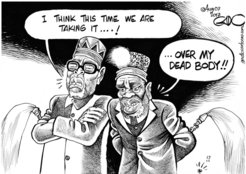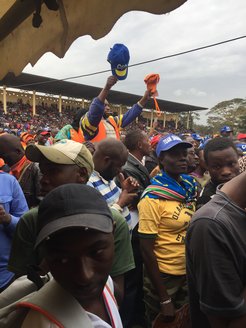Kenya’s 2017 Election
Devolution, Uncertainty, and Unpredictable Electorates
by Elena Gadjanova
Kenyans go to the polls on August 7 in one of the most hotly contested elections in the country’s history. Voters will elect a president, senators, county governors, members of parliament, women’s representatives, and county assembly representatives on the same day. The stakes are very high ![]() because of the state of the economy, historical score-settling between the incumbent and opposition presidential candidates, and looming battles over future succession. The election is also closely watched because for the first time, the effects of Kenya’s new devolved constitution are expected to be felt in its politics. With the threat of ethnic clashes ever present in the country (most election contests since the re-introduction of multi-party competition have been marred with violence) and with recent disturbing developments related to the murder of a leading official from the Independent Borders and Boundaries Commission, analysts are following developments with much concern.
because of the state of the economy, historical score-settling between the incumbent and opposition presidential candidates, and looming battles over future succession. The election is also closely watched because for the first time, the effects of Kenya’s new devolved constitution are expected to be felt in its politics. With the threat of ethnic clashes ever present in the country (most election contests since the re-introduction of multi-party competition have been marred with violence) and with recent disturbing developments related to the murder of a leading official from the Independent Borders and Boundaries Commission, analysts are following developments with much concern.

Six months ago, most observers were predicting an easy victory for the incumbent, Uhuru Kenyatta and his vice president and running mate, William Ruto (dubbed Uhuruto). Instead, opinion polls have shown the race narrowing considerably and the ones taken at the eve of the election show Kenyatta and opposition candidate Raila Odinga neck and neck. This has also been the most expensive electoral campaign in the country to date, reflective of a broader trend in Africa as a whole. It has featured a punishing campaign schedule for the presidential contenders (the incumbent and vice president held 200 rallies in June alone), foreign consultants advising both sides, beefed up logistics and operations including brand new helicopters and sound equipment, and an all out media onslaught including sophisticated and coordinated social media outreach efforts.
The massive campaign spending reflects the stakes in the election and the great underlying uncertainty regarding levels of support. But why did the race become so close? I list five major reasons below.
More diversified and unpredictable electorates
Rapid social transformation has made the previously disciplined electorates more diversified, less loyal, and more discerning. Rather than just speaking to chiefs and elders, a candidate seeking office in 2017 has to address women and youth groups, market traders, religious gatherings, teachers, farmers, nurses, etc. with a carefully honed message and ![]() often an equally carefully chosen gift. As Cheeseman, Lynch, and Willis argue in the case of Kenya and
often an equally carefully chosen gift. As Cheeseman, Lynch, and Willis argue in the case of Kenya and ![]() I have shown for Ghana, voters are increasingly aware of their ability to extract resources from politicians during the campaigns. These settings are no longer the “minimum information environments” seen as conducive to ethnic bloc voting. Voters actively seek out information, require resources, and are willing to punish underperforming incumbents. The youth, particularly in urban areas are notoriously unpredictable. Campaign strategists often refer to young voters as “unmoored” and are at a loss about how best to reach out to them. A whole new generation of candidates has emerged in Kenya’s urban centers,
I have shown for Ghana, voters are increasingly aware of their ability to extract resources from politicians during the campaigns. These settings are no longer the “minimum information environments” seen as conducive to ethnic bloc voting. Voters actively seek out information, require resources, and are willing to punish underperforming incumbents. The youth, particularly in urban areas are notoriously unpredictable. Campaign strategists often refer to young voters as “unmoored” and are at a loss about how best to reach out to them. A whole new generation of candidates has emerged in Kenya’s urban centers, ![]() upending existing rules for how to run campaigns and what wins elections.
upending existing rules for how to run campaigns and what wins elections.

Incumbent performance
The government has also not done well in reigning in the country’s high inflation and unemployment rates. It has not delivered on previous campaign promises and ensured basic public services (such as water in the capital, Nairobi). A number of mega corruption scandals have been traced all the way to the top and the opposition has exploited those to paint a picture of self-enriching aloof elites in contrast rampant poverty among the rest of the population. The ![]() “10 millionaires and 10 million poor” trope has featured in Kenyan campaign discourse for decades, providing a ready-made template and increasing the resonance of this message. Poor incumbent performance and perceptions of corruption are likely to incentivize a protest vote against the government in large urban centers and may depress turnout in Uhuruto’s strongholds of Central and Rift Valley.
“10 millionaires and 10 million poor” trope has featured in Kenyan campaign discourse for decades, providing a ready-made template and increasing the resonance of this message. Poor incumbent performance and perceptions of corruption are likely to incentivize a protest vote against the government in large urban centers and may depress turnout in Uhuruto’s strongholds of Central and Rift Valley.
Campaign messages matter
Other than capitalizing on the incumbent’s failures, the opposition has also been able to articulate campaign messages that have resonated with key constituencies in the country. Raila’s message has resonated with key swing groups, particularly among the Masaai in the Rift Valley and voters around the Coast. Moreover, unlike in 2013, when the issue of the ICC indictment brought the Kikuyu and Kalenjin communities tightly behind Uhuro and Ruto, this time around they have lacked a clear rallying appeal. Instead, the incumbent campaign has fallen back on narratives of Kikuyus “under siege” from enemies throughout the country, drowning out other, more positive messages touting the government’s achievements, such as the new railway connecting Nairobi and Mombasa.
… but can backfire
Fanning Kikuyu “siege mentality” can backfire on the government by consolidating support for the opposition and increasing turnout in opposition strongholds. It can also hurt the president among the Kalenjin, his other key support base and turn off younger, more cosmopolitan urban voters. The opposition candidate, Raila Odinga also came under fire for remarks he made about land in the Rift Valley. By warning the Maasai not to sell land to ‘outsiders’, he waded into the very sensitive terrain of property disputes between indigenes and non-indigenes, which has been a major source of tension in Kenyan politics since decolonization. By appearing to favor the rights of indigenes in one region, ![]() Raila risks alienating so-called “outsiders” in other regions, such as the country’s Kisii communities who have settled throughout in search for employment.
Raila risks alienating so-called “outsiders” in other regions, such as the country’s Kisii communities who have settled throughout in search for employment.
Devolution and “six piece voting”

Finally, by creating counties and establishing the elected office of county governors, the new Kenyan constitution has upended the political dynamic of the country and introduced further uncertainty into the presidential race. County positions are powerful and some of the most hotly contested races this time around have been at the county level. A record-breaking 14 525 candidates are running for office across the various positions, most of them independents. This has loosened both parties’ and chiefs and elders’ hold on the electorate even further.
One clear consequence of this shifting arena of political competition is that ![]() local concerns have come to dominate the election. What is less clear, however, is how these locally competitive races will influence the presidential contest. In the strongholds, presidential candidates have been booed and heckled for encouraging “six piece voting” – asking voters to support their preferred candidates for all six positions on the ballot. Subsequently, presidential hopefuls have preferred to stay away for fear of alienating some supporters. Competitive local races thus may end up decreasing support for the presidential candidates in their own strongholds. In the swing areas, on the other hand, the opposite may be happening. In the past, well-crafted messages have resonated among the swing communities, but the problem has been turn-out. Campaign strategists now hope that competition for lower level offices will bring voters to the polls, which would benefit their candidates for president. Much of all this remains uncertain and there may be other unintended consequences of devolution for the electoral process and politics overall.
local concerns have come to dominate the election. What is less clear, however, is how these locally competitive races will influence the presidential contest. In the strongholds, presidential candidates have been booed and heckled for encouraging “six piece voting” – asking voters to support their preferred candidates for all six positions on the ballot. Subsequently, presidential hopefuls have preferred to stay away for fear of alienating some supporters. Competitive local races thus may end up decreasing support for the presidential candidates in their own strongholds. In the swing areas, on the other hand, the opposite may be happening. In the past, well-crafted messages have resonated among the swing communities, but the problem has been turn-out. Campaign strategists now hope that competition for lower level offices will bring voters to the polls, which would benefit their candidates for president. Much of all this remains uncertain and there may be other unintended consequences of devolution for the electoral process and politics overall.

In sum, the election stakes are high, the contest is very close, and both sides have assured supporters of victory. This is a potentially explosive combination. Uncertain incumbents have been known for resorting to a “menu of manipulation” across the world and much will depend on how legitimate the electoral process is, given significant irregularities in the past. For now, we watch and wait.















